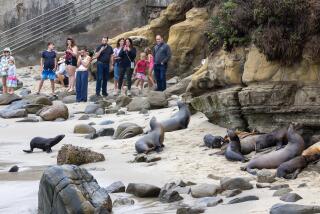At the Sea Life Center, You Can See Life Up Close and Personal
- Share via
When Leslie Shattuck McDonald was growing up near the Back Bay in Newport Beach, she and her friends would swim out to the sand spits and salt marshes to play and beachcomb. But as McDonald grew, so did Newport Beach, and many of the salt marshes that were homes to sea birds--along with marine vegetation and other life unique to that environment--disappeared under the developer’s bulldozer.
Today, McDonald, 35, has returned to her beloved Back Bay as the principal custodian of one of the last saltwater marshes in Orange County--and the only one, she says, that can still be walked by visitors.
A year ago, McDonald, an ichthyologist, established the Sea Life Center at the mouth of the Back Bay near Coast Highway, on a crescent-shaped sand spit about 300 yards long. Owned by the company that also owns an adjacent mobile home park, the saltwater marsh is operated by McDonald under a use permit that allows her and her staff of three volunteers to preserve the marsh in its natural state and to offer classes and tours.
“There’s really no place quite like this left in Orange County,” she said. “There are other salt marsh areas, but this is the only one I know of where you can actually walk out on it and see the variety of life out here.”
McDonald and her staff are treating the sand spit, and its thousands of inhabitants, gingerly. Tours probably will begin in October, but McDonald said only two to three groups a week--with no more than 30 people in a group--will be taken around the spit at a time.
“If more people came out here than that,” she said, “everything would get trampled down. That’s why we’re putting in the walkway.”
The walkway, a boon to visitors who don’t want to squish their way through the heavy marsh mud that forms in some places on the spit, is made of brick and is about 1 1/2 feet wide. The walkway is expected to be completed in time for the tours and will wind from one end of the spit to the other, McDonald said.
Along the route, she said, will be various stops--displays and miniature marine “labs”--where visitors will be able to observe life indigenous to the marsh, such as hundreds of fiddler crabs, carpets of California horn snails, marsh sparrows, ribbed horse mussels, gaper clams that squirt short geysers of water, colorful sea slugs, giant sheep crabs and dozens of varieties of migratory birds that feed on the marsh, particularly in the fall.
The marsh looks unremarkable from a distance, but, as McDonald pointed out, it is an area for close-up study and for scrutiny with the help of a trained guide. In fact, she said, the environment on the spit and the life it supports can change dramatically within a few feet. There are low-tide mud flats, intertidal areas that change with the ebb and flow of the surrounding water, and high or dune areas that can support squirrels and mice.
All levels teem with life, from the microscopic to the giant sheep crab, whose body can measure about a foot across. McDonald said she would make sure visitors see as much as possible.
“We’ll be going pretty slow,” she said. “You don’t want to hurry a tour like this. Actually, with the mud and everything out here, you can’t go very fast.
“It’s a very simple environment, but it’s very special at the same time.”
THE SEA LIFE CENTER AT A GLANCE
Where: 300-A E. Coast Highway, Newport Beach (office located in Bayside Marina Village).
Tours: Times by prior arrangement. Reservations required. Groups of 30 or less.
Admission: Free.
Opening: Scheduled for early October.
Information and reservations: (714) 675-4490.
More to Read
Sign up for The Wild
We’ll help you find the best places to hike, bike and run, as well as the perfect silent spots for meditation and yoga.
You may occasionally receive promotional content from the Los Angeles Times.






